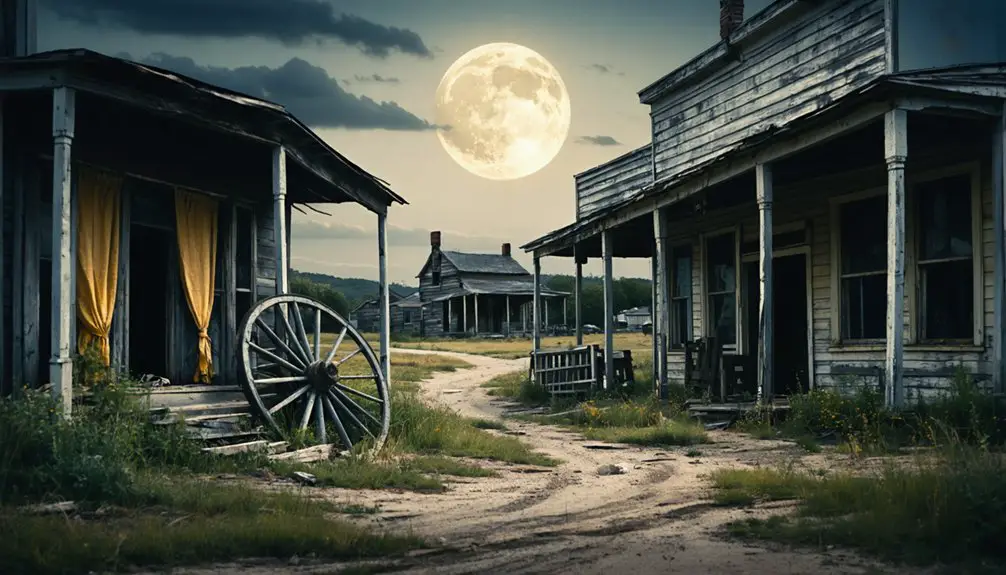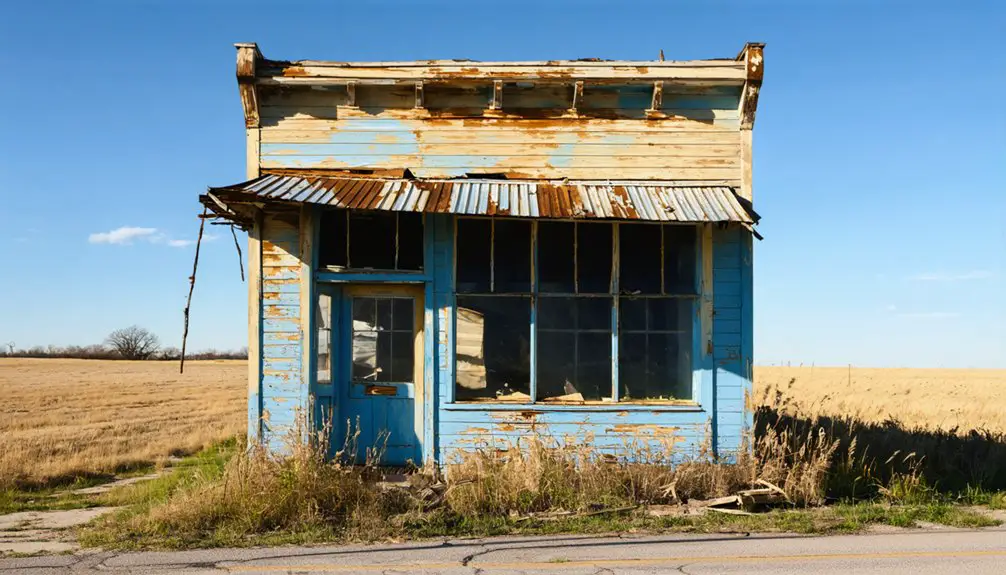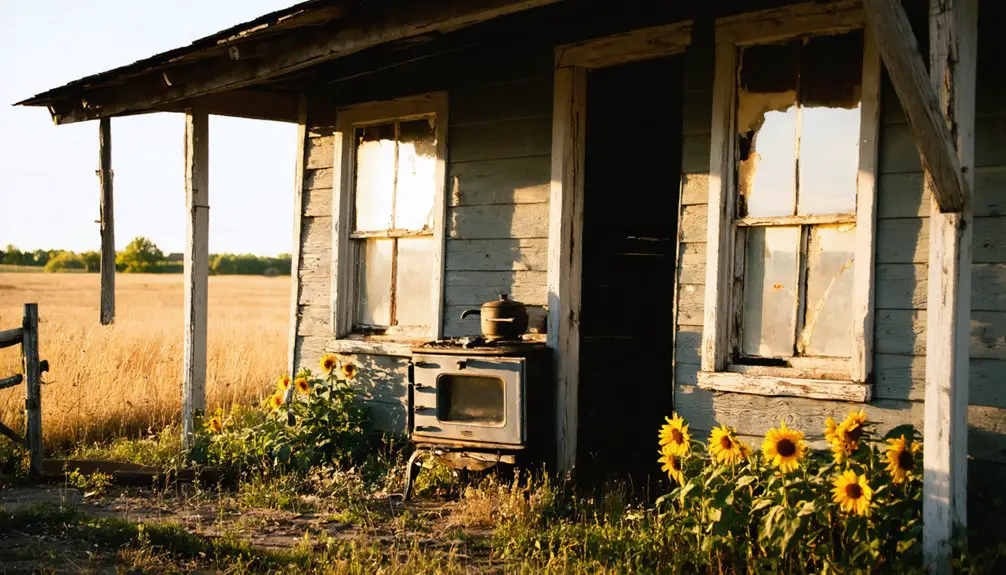You’ll find just a small cemetery today where Ladore, Kansas once stood along Labette Creek. In 1870, this railroad boomtown peaked at 1,500 residents and earned notoriety as one of the American frontier’s most dangerous settlements. Established by controversial pioneer James N. Roach in 1867, the town gained infamy for its lawlessness, vigilante justice, and a mass lynching incident. The dark legacy of this ghost town’s brief, violent existence holds many untold stories.
Key Takeaways
- Ladore was a booming Kansas railroad town established in 1867, reaching a peak population between 900-1,500 residents.
- The town’s downfall began when railroad facilities relocated to Parsons, prompting mass exodus and building relocations.
- Known for lawlessness and violence, Ladore gained notoriety for a mass lynching of five outlaws in 1870.
- Today, only the Ladore Cemetery remains as physical evidence of the once-thriving frontier settlement.
- The town’s brief existence from 1867 to early 1870s exemplifies the boom-and-bust cycle of American frontier settlements.
The Birth of Fort Roach
When James N. Roach sold his Fort Scott property in 1867, he strategically acquired land near Labette Creek in southern Neosho County.
You’ll find that his choice wasn’t random – he’d positioned his early settlement perfectly along the Missouri-Kansas-Texas (MK&T) railroad right-of-way, knowing it would attract growth and commerce.
The railroad influence quickly transformed this frontier outpost.
Within months, a post office opened, marking Fort Roach’s official establishment.
The name was changed to Ladore in 1869.
The promise of the MK&T’s future station and maintenance yards drew settlers by the hundreds.
As railroad workers and entrepreneurs flocked to the area, the population swelled to somewhere between 900 and 1,500 people.
Though the exact reasoning behind Roach’s site selection remains unclear, his business instincts proved sharp in choosing this promising location.
A mission station and church established by Philip Colleton in 1868 helped solidify the growing community.
James N. Roach: A Controversial Pioneer
Behind the establishment of Fort Roach stood a complex and controversial figure from Virginia.
You’ll find James N. Roach‘s influence woven throughout early Kansas Territory history, starting with his arrival in 1857. After spending time in Indiana, he’d made his way to Fort Scott, where he quickly established himself as an innkeeper and tavern owner.
His establishments, the “Roach House” and “Fort Roach,” became known for their rowdy parties and occasional violence, including a shooting involving his son-in-law. A gang of seven men would later terrorize his boarding house in Ladore.
Roach’s political activism earned him a checkered reputation, though his friendship with John Brown suggests his sympathies lay with the free-state cause.
After selling his Fort Scott interests, he’d go on to acquire land near Labette Creek, where he’d later establish the ill-fated town of Ladore. His inn would later become the site of a tragic incident when he was violently assaulted by outlaws.
Life in a Lawless Frontier Town
If you’d walked down Ladore’s Main Street in the late 1860s, you’d have witnessed drunken brawls, public shakedowns, and armed robberies happening in broad daylight.
The town’s numerous whiskey houses operated without restrictions, creating an atmosphere where crime flourished and public disorder became the norm rather than the exception.
With no formal law enforcement present, Ladore earned its reputation as one of Kansas’s most dangerous frontier settlements, where even honest citizens lived in constant fear of being robbed at gunpoint. The town’s dark history included a mass lynching incident, cementing its sordid reputation in Kansas lore.
Daily Life and Violence
During the early 1870s, life in Ladore epitomized the chaos of America’s untamed frontier, where the Missouri, Kansas, and Texas Railroad’s presence attracted a volatile mix of settlers, drifters, and criminals.
Daily routines were marked by community tensions between law-abiding citizens and troublemakers who frequented the bustling railroad town.
You’d have witnessed these stark contrasts in Ladore’s daily life:
- Railroad workers and settlers struggled to maintain order while dealing with frequent robberies and assaults.
- Women and girls lived in constant fear, highlighted by the tragic assault of two teenage victims in 1870.
- The community eventually took justice into their own hands, lynching five outlaws in response to escalating violence.
This vigilante action transformed Ladore from a lawless haven into a more peaceful settlement.
Whiskey Houses Run Wild
Whiskey flowed freely through nearly every house in Ladore, transforming the frontier railroad town into a perpetual drinking establishment.
You’d find saloons and hardware stores dotting the landscape, with most businesses centered around the whiskey trade. At Roach House, the town founder’s infamous inn, you could witness multi-day parties that often ended in drunken shootouts.
The whiskey influence shaped every aspect of daily life, as railroad workers and outlaws alike gathered in these establishments.
You wouldn’t be surprised to see armed men stumbling between taverns, where robberies and brawls erupted regularly. This saloon culture earned Ladore the reputation as “the meanest town in Kansas,” with news of its lawlessness reaching as far as London.
When the railroad bypassed the town, the whiskey houses and their patrons simply moved to Parsons.
Law Enforcement Breaks Down
As Ladore’s population swelled with railroad workers and outlaws in 1870, the town’s lack of formal law enforcement left citizens vulnerable to unchecked violence.
You’d find whiskey flowing freely in nearly every house, fueling frequent armed confrontations that threatened community safety. Without badges or jail cells to maintain order, lawlessness challenges mounted daily.
The breakdown in authority manifested in three stark ways:
- Gangs operated with impunity, culminating in the brutal May 10th attack where seven outlaws assaulted multiple residents.
- Citizens had no official recourse for justice, forcing them to take matters into their own hands.
- Drinking and violence became so widespread that Ladore earned a reputation as one of Kansas’ meanest frontier towns.
These conditions ultimately pushed residents to embrace vigilante justice to restore order.
The Fateful Night of May 1870

You’ll find yourself transported to a harrowing May evening in 1870, when seven armed men terrorized Ladore’s citizens through robbery, assault, and the vicious attack of James Roach and two teenage girls.
As dawn broke the next morning, an enraged mob of 300 locals and railroad workers had captured five of the perpetrators who’d wreaked havoc on their town.
In what became internationally publicized frontier justice, the mob swiftly hanged the five outlaws from a hackberry tree near Roach’s property, sparing only one man who hadn’t participated in the violent spree.
Terror Strikes The Town
The night of May 10, 1870, brought unprecedented terror to Ladore when seven armed men rode into town, marking the start of a horrific 24-hour period that would forever change the frontier settlement.
As whiskey flowed freely through the streets, these outlaws released a wave of violence that tested the community’s resilience. The chaos mirrored the intense rivalry seen during the county seat disputes that plagued Neosho County.
The gang’s brutality escalated quickly:
- They robbed and assaulted innocent townspeople throughout the evening.
- At Roach’s boarding house, they beat the owner nearly to death after he refused them lodging.
- They abducted two teenage chambermaids, dragging them to Labette Creek where unspeakable crimes occurred.
You’d find no hesitation in the town’s response to these atrocities.
Posse Takes Swift Action
When news of the violent gang attacks spread through Ladore at dawn on May 11, 1870, more than 300 armed citizens rapidly mobilized into a vigilante force.
The community response was swift and decisive – within hours, the posse had captured six men, three in Ladore and three more fleeing toward Osage Mission.
Two teenage girls who’d escaped their captors positively identified five of the men as their attackers.
The vigilante action reached its climax when the posse took justice into their own hands, hanging five of the outlaws from a hackberry tree along Labette Creek.
They spared the sixth man, turning him over to local authorities.
This dramatic display of community power marked Ladore’s transformation from a lawless frontier town to a self-policing settlement.
Justice Under Hackberry Tree
Following the rapid formation of the vigilante posse, justice came swiftly at dawn on May 11, 1870, as five identified outlaws met their fate beneath a massive hackberry tree along Labette Creek.
The vigilante motivations stemmed from the community’s determination to end Ladore’s reputation for lawlessness. John William Rhodus witnessed this pivotal moment while serving as a city trustee in the region.
You’ll find these critical elements of frontier justice that day:
- William Ryan, Patrick Starr, Patsey Riley, Richard Pitkin, and Alexander Mathews were hanged side by side on a single limb.
- Their bodies were cut down and buried together in a common grave beneath the tree.
- A sixth suspect was released to authorities after the girls couldn’t positively identify him.
This dramatic community response marked Ladore’s turning point from chaos to order, though the town’s eventual decline would come years later.
Vigilante Justice on the Kansas Prairie

During Kansas’s tumultuous frontier period, vigilante justice emerged as settlers took the law into their own hands, particularly in regions like Butler County where nearly 800 citizens joined vigilante committees by 1870.
You’d find these groups forming in response to perceived failures of local law enforcement, with widespread livestock theft serving as a primary catalyst. In a notable case, James Crawford’s mules were stolen, sparking the formation of a large mob in Douglass. Community dynamics often pitted vigilantes against those they suspected of crimes, including local officials believed to be in league with criminal gangs.
Vigilante groups emerged when settlers lost faith in lawmen, suspecting some officials worked alongside the very criminals they pursued.
The violence escalated quickly, with vigilantes executing at least eight men in Butler County by December 1870. Similar to Dodge City’s approach, local committees would often give troublemakers 24 hours to leave before taking violent action.
While military forces and sheriffs attempted to restore order, you’d see armed resistance from vigilantes who’d justify their actions through manifestos claiming they were protecting pioneer communities from lawlessness and corruption.
Railroad Dreams and Broken Promises
As the Missouri, Kansas & Texas Railroad laid tracks through southern Neosho County in 1867, you’d find ambitious plans taking shape for the frontier town of Ladore.
Railroad speculation drove explosive growth as the MK&T promised to make Ladore a major junction, complete with maintenance yards and a roundhouse.
The fertile farming soil surrounding the area initially attracted many settlers before the railroad’s arrival.
The railroad’s impact transformed Ladore into a bustling boomtown:
- Population surged to nearly 1,500 residents
- Brick buildings and businesses sprang up along Main Street
- Schools and churches established permanent roots
But the MK&T’s promises proved hollow.
When the railroad suddenly moved its facilities south, the economic impact devastated Ladore.
The town that had staked its future on becoming a transport hub watched its dreams vanish as businesses failed and citizens departed, leaving behind empty buildings and broken promises.
From Boom to Abandonment

While Ladore initially promised to be a thriving railroad hub, the town’s explosive growth in 1867 quickly gave way to lawlessness and chaos.
You’d have witnessed daily gunpoint robberies on Main Street, widespread public drunkenness, and violent confrontations as the town attracted both honest settlers and criminals alike.
The railroad speculation that fueled Ladore’s rapid rise ultimately led to its downfall.
Ladore’s destiny was tied to the railroad tracks that never came, turning boom town dreams to dust.
When the Missouri, Kansas & Texas Railway chose a different location for its junction, the town’s fate was sealed.
The complex social dynamics shifted dramatically as residents, facing an uncertain future, made the bold decision to relocate.
Between 50 and 75 buildings were physically moved five miles south to establish Parsons, leaving behind only a cemetery as evidence of Ladore’s brief but turbulent existence.
Echoes in the Cemetery
Today, the Ladore Cemetery stands as the sole sentinel of a vanished frontier town, its weathered headstones rising from surrounding wheat fields just north of Parsons, Kansas.
Within this well-maintained plot of sacred ground, you’ll find powerful cemetery symbolism that echoes the town’s dramatic past and preserves its historical reflections.
Here’s what makes this cemetery particularly significant:
- It’s the last physical remnant of Ladore’s brief but tumultuous existence.
- The graves include many original settlers who witnessed the town’s violent era, including the infamous lynching of outlaws.
- Despite its remote location, local caretakers maintain the grounds, ensuring these pioneers’ stories aren’t forgotten.
This enduring memorial serves as both a tribute to frontier justice and a reminder of how quickly fortunes could change in the American West.
Preserving Ladore’s Memory
Despite Ladore’s complete physical disappearance, a dedicated group of local historians and community members works to preserve the town’s memory through strategic markers and storytelling.
You’ll find an 8×4-foot sign marking the original townsite northwest of Parsons, near Lyon and 25th Road, erected by a local museum board member.
While private land ownership limits physical historical preservation, community engagement continues through the well-maintained Ladore Cemetery – a cultural anchor amid wheat fields that draws descendants and history enthusiasts.
Local historical societies have built a digital archive through published articles and blog posts, ensuring Ladore’s legacy lives on.
Though the town’s notorious reputation and lack of surviving structures pose challenges, dedicated locals keep its memory alive through oral histories and the cemetery’s enduring presence.
Frequently Asked Questions
What Happened to the Two Teenage Girls After the 1870 Incident?
Peculiarly private paths led these girls to vanish from history’s record. You won’t find their fates in Ladore legends or ghost sightings – their stories simply fade into frontier’s forgotten past.
Were Any Descendants of Ladore’s Original Residents Still Living in Nearby Areas?
You’ll find some descendants still connected through Ladore heritage today, particularly near Parsons, Kansas. Local interviews and cemetery records suggest several families maintained ties to the original settlement area.
How Many People Were Buried in Ladore Cemetery During Its Active Years?
You’ll find cemetery records show 83 confirmed burials through tombstone counts, though actual numbers may be slightly higher due to unmarked graves and lost burial rituals from the late 1800s.
What Specific Items Were Stolen During the 1870 Robbery Spree?
You’ll find the robbery details included cash, personal belongings, valuables from lodgers, and items taken during street assaults. Stolen valuables included watches, jewelry, wallets, and whiskey from Roach’s boarding house.
Did James N. Roach Continue Living in Kansas After Ladore’s Decline?
After establishing a dozen Kansas settlements, you’ll find that Roach’s legacy remained in Kansas until his death in 1883, when he was laid to rest in Ladore Cemetery, never leaving Neosho County.
References
- https://www.acatholicmission.org/ladore.html
- https://ozarks-history.blogspot.com/2019/03/deadly-day-in-ladore_31.html
- https://legendsofkansas.com/ladore-kansas/
- https://www.parsonssun.com/article/925
- https://lostkansas.ccrsdigitalprojects.com/sites/lostkansas/files/private_static/2022-12/LT_NO_Ladore_Mog.pdf
- https://khri.kansasgis.org/photos_docs/057-1426_79.pdf
- https://www.kspatriot.org/index.php/articles/18-kansas-military-history/458-forts-in-early-kansas.html
- https://www.northamericanforts.com/West/ks.html
- https://theactiveage.com/graveyard-all-that-remains-of-once-notorious-kansas-town/
- http://genealogytrails.com/kan/neosho/history-3.html



